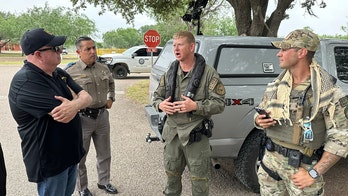
Questions are being raised about the effectiveness -- and toughness -- of the Army Field Manual's interrogation guidelines, the standard ordered across the board by the Obama administration in response to allegations of CIA abuse of detainees.
"The Army Field Manual is very, very restrictive in what it can do," said Michigan Rep. Pete Hoekstra, the top Republican on the House intelligence committee. "For high-value detainees, it's a joke. ... In theory, it sounds great."
The guidelines are all psychological in nature. The methods include good cop-bad cop, the silent treatment, and a trick in which interrogators can pretend to be from another country.
But the administration, which is establishing a special unit for questioning high-value detainees, is now indicating it is open to examining new methods -- even as Attorney General Eric Holder launches a probe into alleged prisoner abuse under the Bush administration.
Critics say the field manual guidelines just might not be enough to shake a hardened terrorist.
Hoekstra said he believes a lot of the intelligence obtained from high-value detainees over the past several years would not have been uncovered if interrogators were limited to the field manual all along. He said going forward, interrogators should be allowed to do more, since the approved techniques are "not going to break anybody."
There are 19 approved techniques in the manual, last updated in 2006. The manual, which Obama designated as the standard for interrogations when he took office, prohibits techniques like waterboarding, electric shock, forced nudity, mock executions and other acts.
It permits interrogators to ask questions in a "rapid fire" sequence; repeat questions over and over; try to break the prisoner by focusing on his emotional anxieties or personal fears; change the environment in which the prisoner is being questioned; and, under very specific circumstances, keep a detainee separated from others.
But in between methods like waterboarding -- which many lawmakers call torture -- and considerably more mild methods like the silent treatment are others that could prove more effective in extracting information while still allowing the Obama administration to keep the moral high ground.
The administration seems to be keeping an open mind. Though officials have said the Army Field Manual will be the standard for U.S. interrogators, as per the recommendations of the task force assigned to review detention policy, the administration is following another recommendation that could lead to changes.
The task force recommended that the new High-Value Detainee Interrogation Group (HIG) develop a set of "best practices." It also recommended that a "scientific research program" be set up to study effectiveness and even develop "new lawful techniques to improve intelligence operations."
Asked about this possibility Monday, senior administration officials said they want to make sure they can "leverage anything that is new," but that any additions would "depend on what the study shows."
"If some recommendation were to come forward to change the ground rules, then I'm sure that would (be) dealt with appropriately," one official said.
Charles Stimson, who as the former deputy assistant defense secretary for detainee affairs worked on the 2006 revision of the field manual, said the administration is expected to consider other techniques.
While Stimson defended the field manual guidelines as effective in many cases, he said there are others that could be put to good use.
"We will be constraining ourselves, inappropriately so, if we confined the CIA (or HIG) to the 19 techniques in the Army Field Manual," he said. "Our enemy trains to our protocol, studies our protocol ... (They) will know how to resist."
Stimson is opposed to waterboarding and other "enhanced interrogation techniques" that were employed under the Bush administration. But he said other methods -- for instance, lying -- should be at the disposal of interrogators. He said any new methods that are devised or approved should stay classified.
While "lying" might seem like an obvious interrogation method, the Army Field Manual only approves it in very specific circumstances.
Under the "we know all approach," interrogators are allowed to "subtly" convince the prisoner that they know what he or she knows. This can be complemented by the "file and dossier" approach, in which interrogators present a "file" to a prisoner that appears to be much bigger than it really is, by being "padded with extra paper" and other decorations.
Other methods are mild enough to be authorized in any school principal's office.
One method, the "direct approach," is simply when the interrogator asks questions. Another involves creating incentives for cooperation. The "emotional pride" approach is when the interrogator flatters the prisoner into cooperating by appealing to his ego. The "silent approach" is also relatively mild.
"When employing this technique, the (interrogator) says nothing to the source, but looks him squarely in the eye, preferably with a slight smile on his face," the guide says, urging the interrogator not to be the first to break eye contact.
Peter Brookes, a senior fellow with the Heritage Foundation who served in the CIA, said the effectiveness of these techniques varies from prisoner to prisoner.
"It's not black and white," he said.
But he said they can be limiting.
"The real challenge isn't just getting information. It's getting good information and getting it in a timely manner," Brookes said.
The new interrogation unit would report to the White House-based National Security Council.
Dean Boyd, a spokesman with the Department of Justice security division, told FOX News in an e-mail that it's not yet clear whether new techniques will be authorized.
"At this time, we are not in a position to speculate on what, if any, new lawful techniques might be identified by such research, much less on whether such techniques might be adopted," he said.
FOX News' Mike Levine contributed to this report.




